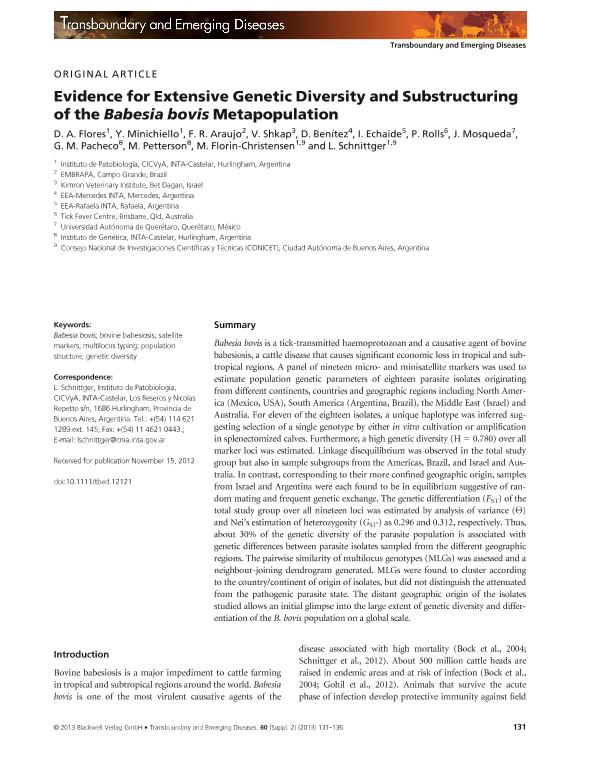Artículo
Evidence for Extensive Genetic Diversity and Substructuring of the Babesia bovis Metapopulation
Flores, Daniela Agustina ; Minichiello, Y.; Araujo, F. R.; Shkap, V.; Benítez, D.; Echaide, Ignacio Eduardo; Rolls, P.; Mosqueda, J.; Pacheco, G. M.; Petterson, M.; Jacobsen, Monica Ofelia
; Minichiello, Y.; Araujo, F. R.; Shkap, V.; Benítez, D.; Echaide, Ignacio Eduardo; Rolls, P.; Mosqueda, J.; Pacheco, G. M.; Petterson, M.; Jacobsen, Monica Ofelia ; Schnittger, Leonhard
; Schnittger, Leonhard
 ; Minichiello, Y.; Araujo, F. R.; Shkap, V.; Benítez, D.; Echaide, Ignacio Eduardo; Rolls, P.; Mosqueda, J.; Pacheco, G. M.; Petterson, M.; Jacobsen, Monica Ofelia
; Minichiello, Y.; Araujo, F. R.; Shkap, V.; Benítez, D.; Echaide, Ignacio Eduardo; Rolls, P.; Mosqueda, J.; Pacheco, G. M.; Petterson, M.; Jacobsen, Monica Ofelia ; Schnittger, Leonhard
; Schnittger, Leonhard
Fecha de publicación:
11/2013
Editorial:
Wiley Blackwell Publishing, Inc
Revista:
Transboundary And Emerging Diseases
ISSN:
1865-1674
Idioma:
Inglés
Tipo de recurso:
Artículo publicado
Clasificación temática:
Resumen
Babesia bovis is a tick-transmitted haemoprotozoan and a causative agent of bovine babesiosis, a cattle disease that causes significant economic loss in tropical and subtropical regions. A panel of nineteen micro- and minisatellite markers was used to estimate population genetic parameters of eighteen parasite isolates originating from different continents, countries and geographic regions including North America (Mexico, USA), South America (Argentina, Brazil), the Middle East (Israel) and Australia. For eleven of the eighteen isolates, a unique haplotype was inferred suggesting selection of a single genotype by either in vitro cultivation or amplification in splenectomized calves. Furthermore, a high genetic diversity (H = 0.780) over all marker loci was estimated. Linkage disequilibrium was observed in the total study group but also in sample subgroups from the Americas, Brazil, and Israel and Australia. In contrast, corresponding to their more confined geographic origin, samples from Israel and Argentina were each found to be in equilibrium suggestive of random mating and frequent genetic exchange. The genetic differentiation (FST) of the total study group over all nineteen loci was estimated by analysis of variance (Θ) and Nei's estimation of heterozygosity (GST') as 0.296 and 0.312, respectively. Thus, about 30% of the genetic diversity of the parasite population is associated with genetic differences between parasite isolates sampled from the different geographic regions. The pairwise similarity of multilocus genotypes (MLGs) was assessed and a neighbour-joining dendrogram generated. MLGs were found to cluster according to the country/continent of origin of isolates, but did not distinguish the attenuated from the pathogenic parasite state. The distant geographic origin of the isolates studied allows an initial glimpse into the large extent of genetic diversity and differentiation of the B. bovis population on a global scale.
Archivos asociados
Licencia
Identificadores
Colecciones
Articulos(SEDE CENTRAL)
Articulos de SEDE CENTRAL
Articulos de SEDE CENTRAL
Citación
Flores, Daniela Agustina; Minichiello, Y.; Araujo, F. R.; Shkap, V.; Benítez, D.; et al.; Evidence for Extensive Genetic Diversity and Substructuring of the Babesia bovis Metapopulation; Wiley Blackwell Publishing, Inc; Transboundary And Emerging Diseases; 60; SUPPL.2; 11-2013; 131-136
Compartir
Altmétricas



